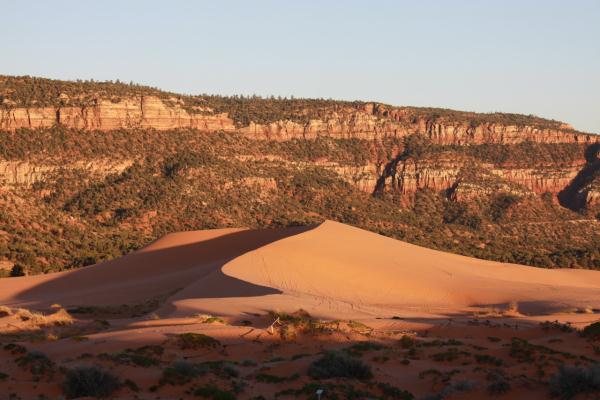Coral Pink Sand Dunes State Park

About Coral Pink Sand Dunes State Park
Coral Pink Sand Dunes State Park is a Utah state park located between Mount Carmel Junction and Kanab, south and west of U.S. Highway 89 in Southwestern Utah.
The park was established in 1963 with land acquired from the Bureau of Land Management to serve as access to the dunes for recreation, and to protect the dune resources.
Coral Pink Sand Dunes State Park (6,000 ft.) encompasses 3,730 acres of southwestern Utah where a stunning, coral-colored dunefield is surrounded by red Navajo Sandstone cliffs, blue skies and juniper/pinyon forests.
A 265acre conservation area prohibits motorized vehicles in order to protect the Coral Pink Beetle (found nowhere else in the world) and all the other habitats, like Mule Deer, Jackrabbit, Kit Fox, Coyote.
This park provides a fantastic setting for camping, hiking, off-highway vehicle riding, taking photographs, geocaching or just playing in the sand.
How the dunes formed
The Dunes are estimated to be between 10,000 and 15,000 years old. They formed from the erosion of pink-colored Navajo Sandstone cliffs to the south. The winds are the same prevailing winds occurring throughout the southwest. The unique influence upon the wind is found by looking south to the notch between the Moquith and Moccasin Mountains. The wind is funneled through this constricting notch, thereby increasing wind velocity to a point where it can carry sand grains. This phenomenon is known as a Venturi Effect. Once the wind passes through the notch and into the open valley, the winds velocity decreases, causing the sand to be deposited.
Dunes
As winds gather sand into dunes, recognizable forms emerge. The southern-most dune at Coral Pink is called barchan dune.
Barchan dunes are shaped like a crescent moon. As the dune grows, sand is blown around the edges producing tips or "horns" pointing forward with the direction of the wind.
The dune directly in front of the platform is a star dune. When sand-filled winds collide and jettison sand in windy spirals, sand star dunes form, their numerous ridges radiating from the center like pinwheels. Star dunes grow vertically rather than horizontally. Coral Pink's star dune is about 100 feet tall from base to peak.
Hiking the sand dunes is an interesting and colorful experience. A number of trails adjacent to the park provide excellent hiking. Watch out for OHVs !
We highly recommend the small loop staring at the visitors platform. You get a lot more Information along the way, but you might get sand in your shoes....
And don't miss GC1M6Z3 a cache by Utah State Parks
To get credit for this cache please send us a note with answers to the following questions:
1. The Coral Pink Sand Dunes are the only major dune field in the Colorado Plateau region. How long is it?
2. The sand originates from Navajo Sandstone beds to the south. Where does the color result from?
3. In order to have sand dunes, three factors must be present. What are these factors?
I would be nice if you take a picture of the dunes and upload with your log.
You can log your find as soon as you send me the answers. I will contact you if there is a problem.
The above information was compiled from the following sources:
- Wikipedia, the free encyclopedia
- Coral Pink Sand Dunes State Park
- www.desertusa.com